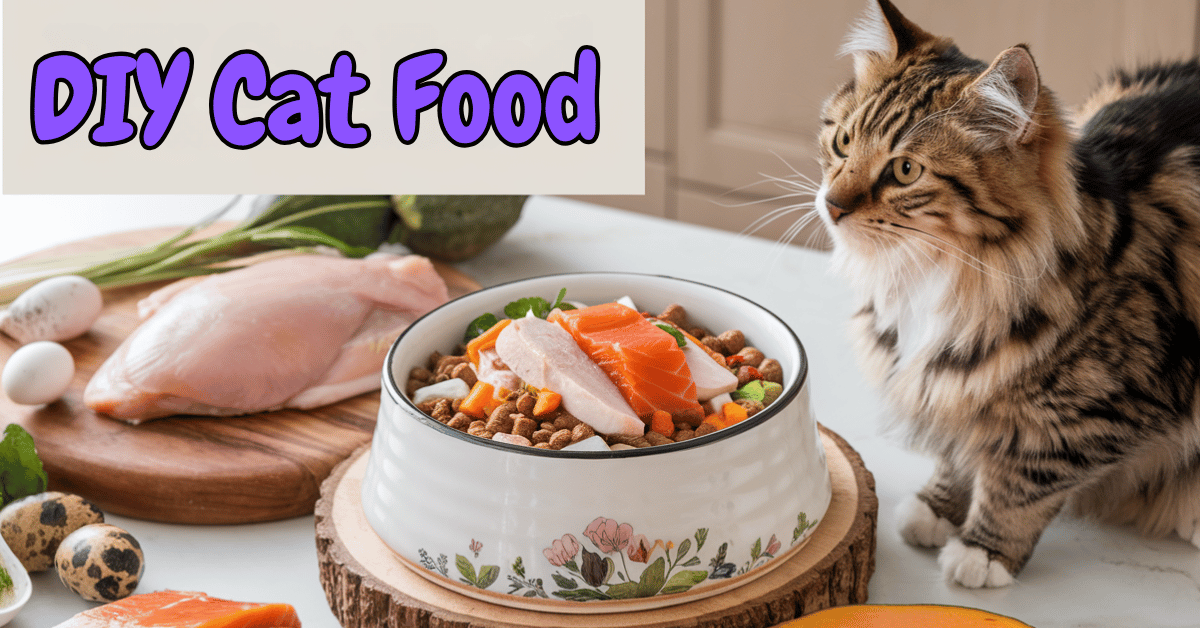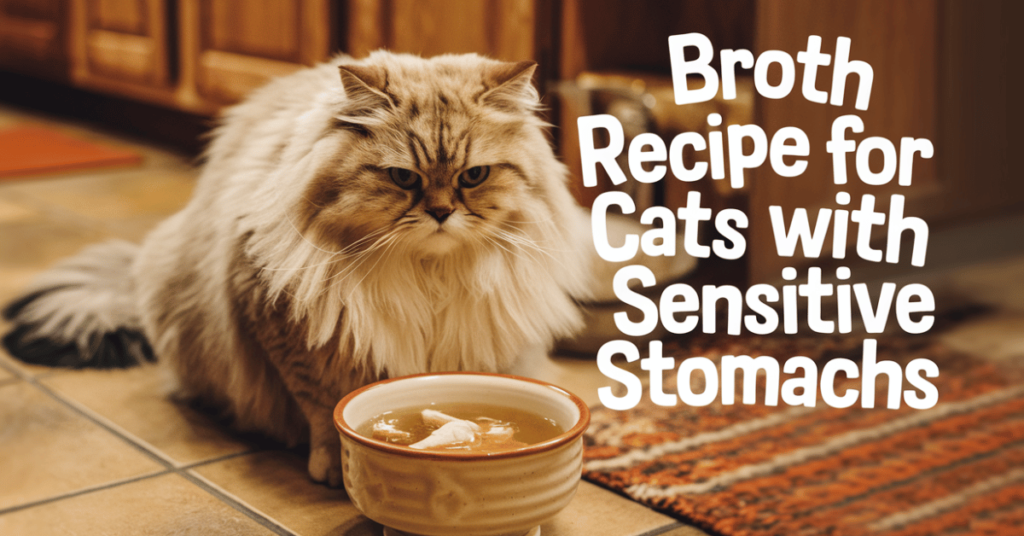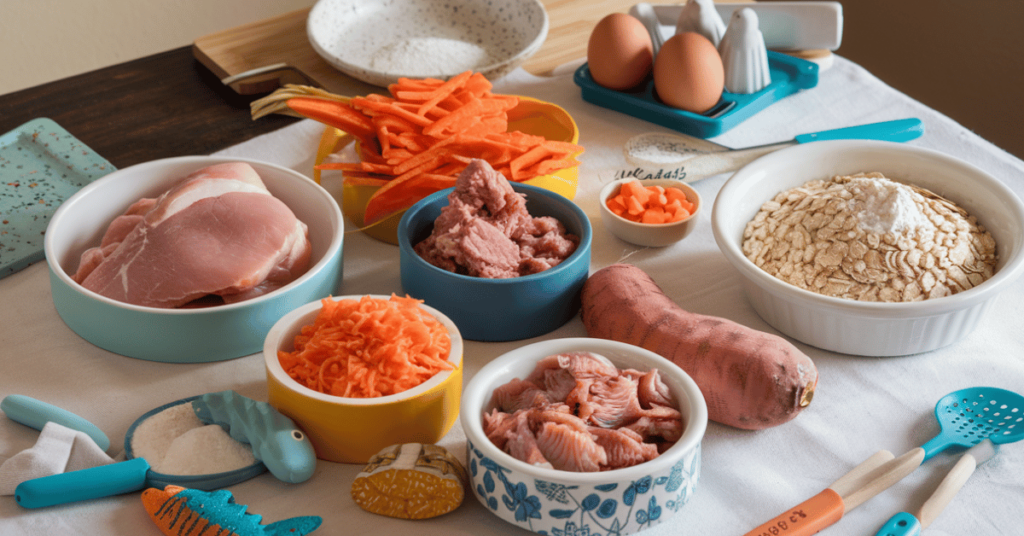Introduction to DIY Cat Food: Feeding Your Cat Naturally
Feeding your cat isn’t just a routine task—it’s an opportunity to enhance their health and well-being through carefully prepared meals. If you have a passion for cooking and a desire to provide the best for your feline friend, creating DIY cat food can be a rewarding endeavor. By making your own cat food, you control the quality of ingredients, ensure nutritional balance, and cater to your cat’s specific dietary needs.
In this guide, we’ll explore homemade cat food recipes that not only satisfy your cat’s palate but also allow you to showcase your culinary skills. Let’s dive into the world of natural feeding and discover how you can elevate your cat’s diet with these step-by-step recipes.
Important Considerations Before You Start
Before you begin crafting homemade cat food recipes, it’s crucial to understand your cat’s nutritional needs. Cats are obligate carnivores, requiring a diet rich in animal proteins and specific nutrients like taurine, arginine, and certain vitamins and minerals that they cannot produce on their own.
Consulting with a veterinarian or a pet nutritionist is essential to ensure that the recipes you prepare are balanced and appropriate for your cat. They can provide guidance on necessary supplements and help you avoid common pitfalls that could lead to nutritional deficiencies.
Homemade Cat Food Recipes
Recipe 1: Gourmet Chicken and Quail Feast
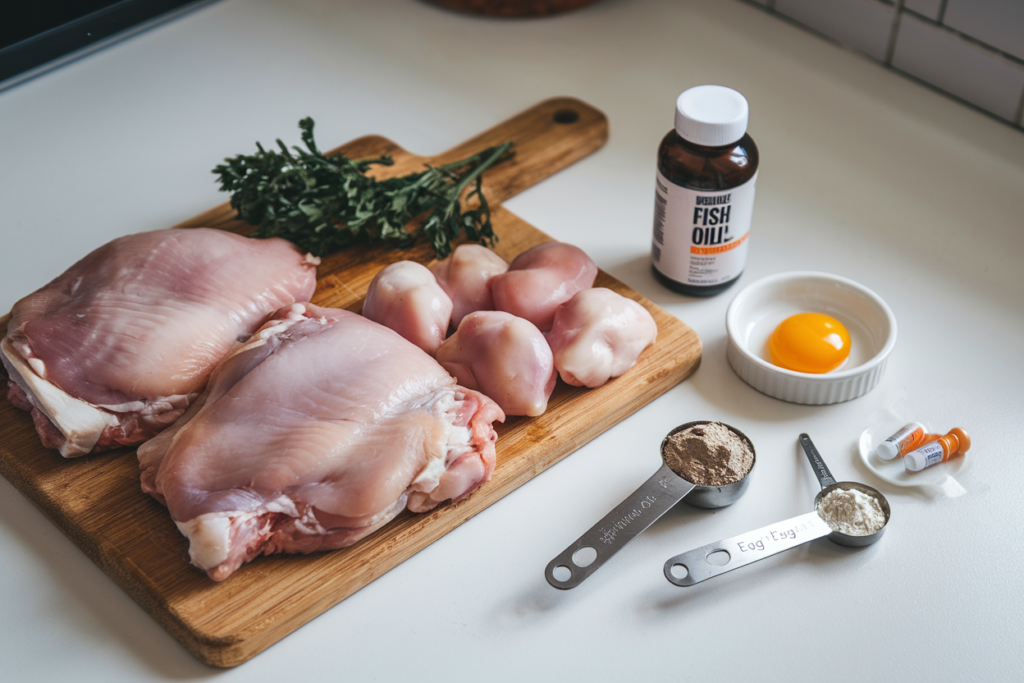
An elegant dish that combines tender chicken and delicate quail, enriched with essential nutrients to support your cat’s health.
Ingredients
- Organic Chicken Thighs (with skin and bones) – 1 pound
- Whole Quail (including bones and organs) – 0.5 pound
- Chicken Liver – 2 ounces (0.125 pound)
- Egg Yolk (raw) – 1 large
- Fish Oil – 1 teaspoon (for omega-3 fatty acids)
- Taurine Supplement – 2,000 mg
- Vitamin B-Complex Supplement – 50 mg
- Vitamin E Supplement – 100 IU
- Finely Ground Eggshell Powder – 1 teaspoon (for calcium, if not using bones)
- Unsalted Chicken Bone Broth – 1 cup (optional, for moisture)
Instructions
- Preparation: Rinse the chicken thighs, quail, and chicken liver under cold water and pat them dry with paper towels. If desired, trim excess fat from the meats.
- Grinding the Meats: Use a meat grinder capable of handling bones to grind the chicken thighs, quail, and chicken liver together. Grinding the bones is important as it provides essential calcium in a natural form. If you do not have a grinder that can handle bones, you can use boneless meats and add finely ground eggshell powder to the mixture to supply the necessary calcium.
- Mixing the Ingredients: In a large mixing bowl, combine the ground meat mixture with the raw egg yolk and fish oil. The egg yolk adds valuable nutrients and helps bind the ingredients, while the fish oil supplies omega-3 fatty acids beneficial for your cat’s skin and coat.
- Adding Supplements: Dissolve the taurine, vitamin B-complex, and vitamin E supplements in a small amount of water or bone broth. Pour this solution into the meat mixture, ensuring that you mix thoroughly to distribute the supplements evenly throughout the food. This step is crucial, as these nutrients are essential for your cat’s heart health, metabolism, and immune function.
- Adjusting Consistency: Gradually add the unsalted chicken bone broth to the mixture to achieve a moist yet firm consistency. The bone broth not only enhances the flavor but also provides additional nutrients and hydration, which can be beneficial for your cat’s overall health.
- Portioning the Meals: Divide the mixture into individual meal-sized portions based on your cat’s daily caloric needs. Using a kitchen scale can help ensure accuracy and consistency in portion sizes, which is important for maintaining your cat’s ideal weight.
- Proper Storage: Place the portions into airtight containers. Store meals that will be used within the next 2-3 days in the refrigerator. Freeze the remaining portions to preserve freshness, where they can be kept for up to three months. Remember to thaw frozen meals in the refrigerator before serving.
Nutritional Highlights
This gourmet recipe is rich in high-quality animal protein, meeting your cat’s natural dietary requirements as an obligate carnivore. The inclusion of organ meats like liver provides essential vitamins and minerals, while the ground bones or eggshell powder ensure an adequate calcium intake for strong bones and teeth.
The added supplements of taurine, vitamin B-complex, and vitamin E are vital for supporting heart function, energy metabolism, and immune health. The fish oil contributes omega-3 fatty acids, promoting a healthy skin and shiny coat.
Recipe 2: Elegant Salmon and Pumpkin Medley
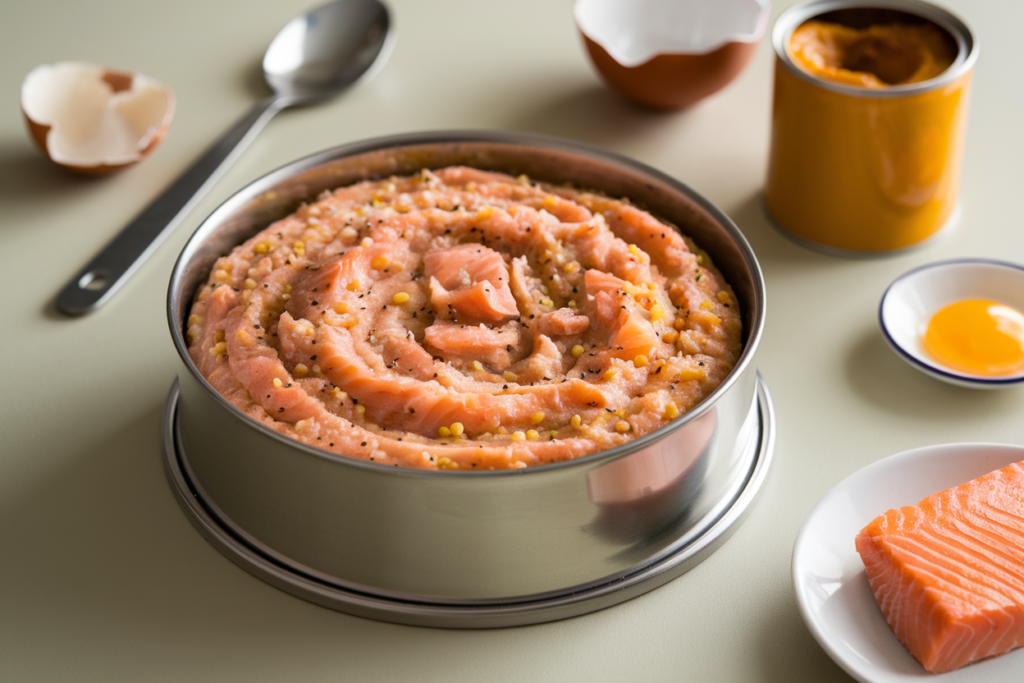
An exquisite blend of succulent salmon and wholesome pumpkin, this recipe provides a rich source of omega-3 fatty acids and dietary fiber, promoting your cat’s overall health and digestion.
Ingredients
- Wild-Caught Salmon Fillets (boneless, skinless) – 1 pound
- Pumpkin Purée (unsweetened, not pie filling) – 2 ounces (0.125 pound)
- Chicken Hearts – 2 ounces (rich in natural taurine)
- Egg Yolk (raw) – 1 large
- Safflower Oil – 1 teaspoon (for omega-6 fatty acids)
- Taurine Supplement – 2,000 mg (if additional supplementation is necessary)
- Vitamin B-Complex Supplement – 50 mg
- Vitamin E Supplement – 100 IU
Instructions
- Preparation: Rinse the salmon fillets and chicken hearts under cold water, then pat them dry. Lightly cook the chicken hearts by boiling or steaming them for a few minutes to eliminate any surface bacteria, while keeping the interior slightly rare to preserve nutrients.
- Cooking the Salmon: Steam or bake the salmon until it’s just cooked through. Overcooking can reduce the nutrient content and make the fish less palatable for your cat. Allow the salmon to cool slightly before handling.
- Processing the Ingredients: In a food processor, combine the cooked salmon, chicken hearts, pumpkin purée, and raw egg yolk. Blend the mixture until it reaches a smooth, pâté-like consistency. The pumpkin adds a delicate sweetness and provides dietary fiber, aiding in digestion.
- Incorporating Supplements: Dissolve the taurine (if using), vitamin B-complex, and vitamin E supplements in a small amount of water. Add this solution, along with the safflower oil, to the salmon mixture. Blend again to ensure all supplements are evenly distributed throughout the food.
- Adjusting Texture and Consistency: If the mixture appears too thick, you can add a small amount of water or homemade fish broth to achieve the desired consistency. The goal is a smooth, moist texture that’s easy for your cat to eat.
- Portioning and Storage: Divide the food into individual servings appropriate for your cat’s size and dietary needs. Place the portions into airtight containers. Refrigerate the meals you plan to use within the next 2-3 days, and freeze the rest to maintain freshness. Remember to thaw frozen meals in the refrigerator before serving.
Nutritional Highlights
This elegant recipe is abundant in high-quality protein and essential fatty acids. The wild-caught salmon provides omega-3 fatty acids, which are crucial for maintaining healthy skin and a lustrous coat.
Chicken hearts are a natural source of taurine, supporting heart and eye health. The pumpkin purée adds fiber, promoting healthy digestion and weight management. By combining these ingredients, you’re offering a nutritionally balanced meal that caters to your cat’s natural dietary instincts.
Advanced Cooking Techniques for DIY Cat Food
To truly showcase your culinary prowess and enhance the nutritional value of your DIY cat food, consider incorporating advanced cooking techniques:
Sous-Vide Cooking
Sous-vide is a method of cooking where food is sealed in airtight bags and submerged in a temperature-controlled water bath. This technique allows for precise cooking, preserving the maximum amount of nutrients and ensuring perfect texture.
Benefits for Cat Food Preparation
- Retains moisture and natural juices in meats.
- Preserves heat-sensitive nutrients that might be lost during traditional cooking methods.
- Reduces the risk of overcooking, which can make proteins tough and less palatable.
How to Apply
- Seal the meat (e.g., chicken, turkey, or fish) in food-grade vacuum bags.
- Set the sous-vide machine to the appropriate temperature for the type of meat you’re cooking (usually between 140°F to 160°F for poultry and fish).
- Cook for the recommended time, ensuring the meat reaches a safe internal temperature.
- Once cooked, cool the meat before incorporating it into your recipes.
Making Homemade Bone Broth
Bone broth is a nutrient-rich liquid made by simmering bones and connective tissues. It’s an excellent addition to your cat’s diet, providing minerals and gelatin for joint health.
Preparation Steps
- Use bones from chicken, turkey, or beef (avoid pork bones due to higher fat content).
- Place the bones in a large pot or slow cooker, covering them with water.
- Add a small amount of apple cider vinegar (about 1-2 tablespoons) to help extract minerals from the bones.
- Simmer on low heat for 24-48 hours, skimming off any foam or impurities.
- Strain the broth, discarding the bones. Ensure no small bone fragments remain, as they can be hazardous.
- Cool the broth and remove the layer of fat that solidifies on top before using it in your recipes.
Dehydrating Homemade Treats
Creating dehydrated meat treats is a healthy way to reward your cat without relying on commercial products that may contain preservatives or additives.
Steps to Dehydrate Meat
- Slice lean meats like chicken breast or beef into thin strips.
- Arrange the strips on dehydrator trays or baking sheets if using an oven.
- Dehydrate at a low temperature (around 140°F) until the meat is thoroughly dried and chewy.
- Store the treats in airtight containers. They can last several weeks when properly dried and stored.
Ensuring Nutritional Balance in Homemade Cat Food
While preparing gourmet meals for your cat is gratifying, it’s imperative to maintain nutritional balance to support their health.
Rotate Protein Sources
Varying the types of protein in your cat’s diet can prevent nutritional deficiencies and reduce the risk of food sensitivities.
Suggestions
- Alternate between chicken, turkey, duck, rabbit, and fish.
- Introduce novel proteins like venison or pheasant if available.
Monitor Your Cat’s Health
Regular observation and veterinary check-ups are crucial to ensure your cat thrives on a homemade diet.
What to Watch For
- Weight Changes: Sudden weight gain or loss may indicate dietary imbalances.
- Coat Condition: A shiny, soft coat reflects good health; a dull coat may signal nutritional deficiencies.
- Energy Levels: Lethargy or hyperactivity can be signs of dietary issues.
Supplement Wisely
Even with high-quality ingredients, supplements are often necessary to meet all of your cat’s nutritional needs.
Key Supplements
- Taurine: Essential for heart and eye health.
- Omega Fatty Acids: Support skin and coat health.
- Vitamins and Minerals: Necessary for various bodily functions.
Consult a Professional
- Work with a veterinarian or a pet nutritionist to determine the appropriate supplements and dosages for your cat.
Transitioning Your Cat to a Homemade Diet
Switching your cat from commercial food to homemade cat food should be done gradually to prevent digestive upset.
Steps for a Smooth Transition
- Start Slow: Begin by mixing a small amount (about 10%) of the homemade food with your cat’s regular food.
- Gradual Increase: Every few days, increase the proportion of homemade food by another 10-20%, while decreasing the commercial food accordingly.
- Monitor Reactions: Watch for any signs of gastrointestinal distress, such as vomiting or diarrhea. If these occur, slow down the transition process.
- Be Patient: Some cats may be resistant to change due to taste or texture preferences. Patience and persistence are key.
Tips for Success
- Consistency: Serve the food at the same time and place each day to establish a routine.
- Warm the Food: Gently warming the homemade food can enhance its aroma, making it more appealing.
- Positive Reinforcement: Praise your cat when they eat the homemade food to create a positive association.
DIY Cat Food: The Natural Path to Feline Well-being
Embarking on the journey of preparing DIY cat food is a profound expression of love and commitment to your feline companion’s health and happiness. By investing time and care into crafting these sophisticated homemade cat food recipes, you ensure that your cat receives the highest quality nutrition tailored specifically to their needs.
Not only does this practice allow you to control every ingredient that goes into your cat’s diet, but it also offers you the opportunity to refine your culinary skills and explore advanced cooking techniques. Remember, the foundation of a successful homemade diet lies in balance, quality ingredients, and ongoing consultation with veterinary professionals.
Meet Sean, a fintech whiz with a penchant for pet purrs and blockchain buzz. After a decade of fintech feats, Sean’s tech talents leaped from ledger lines to litter lines, driven by a passion for pets and a vision for a more connected pet care community. With three critter companions as co-pilots, Sean launched this blog to share a treasury of pet-friendly tech tips and tales.

